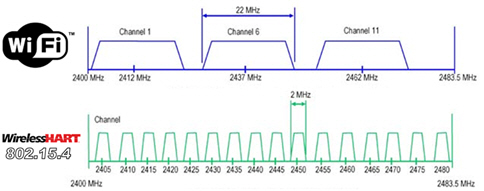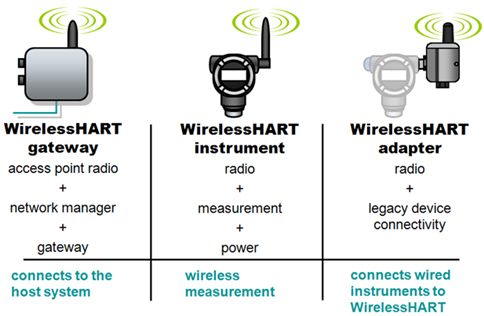Technology

In 2007, the HART Communication Foundation released the first wireless standard specifically developed for industrial applications. WirelessHART, a subset of the HART 7 standard, is a low power wireless technology meant for process measurement applications, eliminating or augmenting 4-20mA signal wires.
The technology behind WirelessHART is what gives the standard its robustness and dependability, and is well developed for ease of use with only a few configuration parameters and specific device types.


Global RF Technology
Built on an IEEE 802.15.4 radio platform operating in the license-free 2.4GHz ISM band, WirelessHART is a globally available standard with a 10mW radio transceiver. The 802.15.4 radio is frequently used for low power radio networks, including Zigbee. The WirelessHART protocol resides on the upper four layers of the 7-layer model and addresses the primary weaknesses of most low power wireless technologies with improved coexistence and radio frequency (RF) channel management through a number of mechanisms, including a combination of Direct Sequence Spread Spectrum (DSSS) and channel hopping, clear channel assessment (CCA), short transmission times, and channel blacklisting.



Full-mesh routing
A key attribute of WirelessHART is its ability to self-organize into a “full-mesh” network, so that every device has multiple redundant communication paths with a line of site range of approximately 250m, and typical installed range of 50-100m. There are no reduced-function or non-routing nodes. A full-mesh topology with self-organizing and self-healing characteristics lets the network maintain long-term, hands-off reliability and predictability in spite of changing environments. Every device has the intelligence to discover neighbors, measure RF signal strength, acquire synchronization and frequency hopping information, and then form or break links with neighbors. The network is defined by a unique ID that is used to bind nodes together into a network, allowing multiple networks to coexist without sharing data or misrouting messages.



Time Synchronized Communication
Both the RF channel management and mesh capabilities are reliant on timing. WirelessHART employs Time Division Multiple Access (TDMA) to manage how the spectrum is used over time. Every transmission takes place in a 10ms window called a “time slot” and on one of the 15 channels with very precise timing. If no communication is needed, devices go into a sleep mode to conserve energy (most devices are battery powered).



Secure message transfer
Three Pillars of Security provides mechanisms for encryption, authentication and integrity – 128-bit AES encryption guarantees information cannot be read by other parties; authentication verifies the sender’s validity through the use of packet source addresses protected by 32-bit Message Integrity Codes (MIC); and integrity ensures that the message is delivered unaltered via the same MIC. Additionally, frequency hopping provides some level of security because of the pseudo-random hopping sequence.


WirelessHART Network
Network formation is a secure process to authenticate devices before they are allowed to join the network. Network advertisements, or beacons, are periodically broadcast by the devices that are already in the network. In order to join the network, a new device must receive a beacon. Once the beacon is heard, the new device will send a join request to the network manager, which resides at the top of the WirelessHART network. The join request consists of the device’s programmed Network ID, Join Key, and other identifying information. If the network ID and join key are accepted by the network manager, it will respond to the new device with authorization information, the data path through the mesh, and the time slots on which the device should transmit. After this, the device is completely joined to the network and can begin publishing data.



Three WirelessHART types



WirelessHART Gateway:
The apparatus that is becoming known as a WirelessHART gateway actually consists of 3 pieces according to the HART standard. The radio that connects to the remote field devices is the Access Point radio. The network manager is the software that acts as the “brain” for the mesh network, controlling the mesh links and managing the security and authentication of the field devices. The Network Manager also optimizes traffic through the network to provide each device with the necessary resources to transmit data in the desired intervals.
Finally, the gateway is the portal between the plant network or host system and the WirelessHART network. These three pieces may be co-located in one package, or split in any combination, including future implantation of multiple Access Points.
WirelessHART Instrument:
A WirelessHART device (commonly a wireless instrument) contains a radio integrated with measurement or monitoring capabilities, allowing easy expansion of an existing plant or a rapid deployment in a new installation. Measurement points previously inaccessible due to cabling costs or environmental restrictions can now be captured with ease. Many different sources can power these devices including solar, line, loop or battery.
WirelessHART Adapter:
The WirelessHART adapter is used to connect an existing wired HART device into a WirelessHART network. The adapter connects to the 4-20mA wiring to gather the HART signal while the 4-20mA signal remains intact and functional. It is possible for one WirelessHART adapter to collect HART signals from multiple devices, resulting in a lower installation cost. It can be loop, line, or battery powered. The primary application for an adapter is to gather HART data from a previously installed HART device that is connected to a host with no HART capability.



